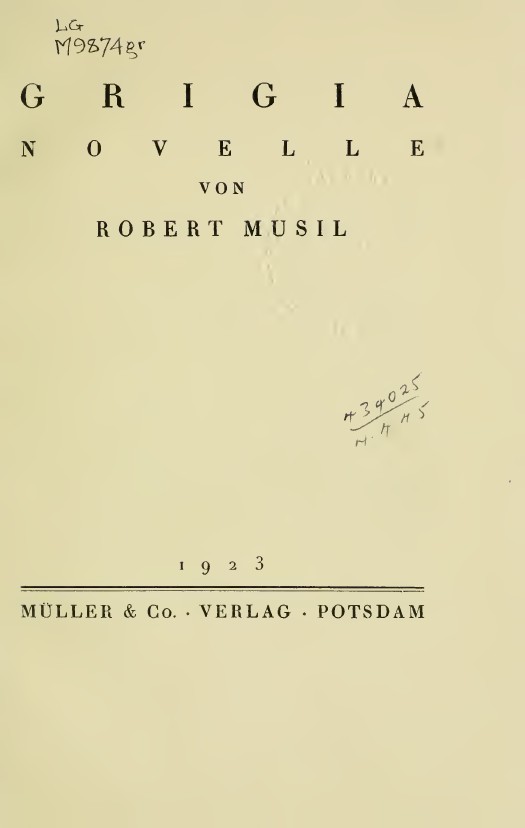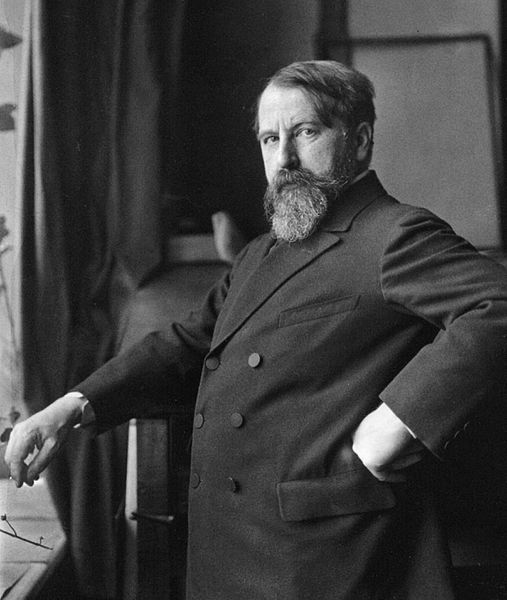There are some books which, when I take my notes from page to screen, seem more interesting and more enjoyable than they had been as I was reading them. Robert Musil’s Three Women is such a book. Three Women is interesting – I got awfully excited by the thought of all the essays I’ll be able to write next year on it – but it’s not exactly fun to read. Musil takes three different relationships and uses them to weave an intricate network of ideas and associations which provide an intellectual feast for anyone who hungers for one, built on workable plots.
This is, of course, progress for Musil, whose two stories Unions were also in my edition. These were written earlier, and as Frank Kermode writes of Three Women in the preface to my edition, “the difference from the earlier work could be expressed as a new willingness to find a place in his stories for straight narrative”, which is about as open as any serious literary critic could be about the fact that those two stories make no bloody sense whatsoever, however interesting they might be for someone who has got lost on the way to the philosophy section of the library.
Anyway, as I said at the top, now that I’ve extracted my notes, I can start to “appreciate” the stories. What follows is a teasing out of some of the various meanings I found.

Three Women and Robert Musil
There are three stories in Three Women, each of them centring on a different woman – “Grigia”, “The Lady from Portugal”, and “Tonka”. The last of these, “Tonka”, as about twice as long as the others, and is also broken up into chapters to make it easier to read. Robert Musil, their author, was an Austrian-German who had seem the Austro-Hungarian Empire collapse, but as Kermode makes clear, this is not the only collapse he witnessed. There is also the sense of “metaphysical collapse”, a sense that modern man (and everyone else) is losing his spiritual anchoring without replacing it with anything. In all of these stories the notion of “will” is of great importance, as is the feeling that looking at the world from only one angle, whether scientific or martial, can lead to our doom. Pretty typical Modernist stuff, to be fair, but Musil does it well.
Grigia
“Grigia” is the first story in Three Women and it takes its name from a peasant woman from Venetia. Homo, the main character, is left home alone by his wife and ailing son as they seek out treatment, so he decides to take up an offer from an old friend to go and attempt to reopen some gold mines in Venetia. Mines are a particularly German setting, taking us back at once to the Romantics. Novalis had studied mining, and Ludwig Tieck’s “The Rune Mountain” and E. T. A. Hofmann’s story “The Mines at Falun” both present classic renditions of the dangers of what lies buried beneath the ground. Of these three, I found “The Mines at Falun” to be the most relevant while I thought about “Grigia”.
In Musil’s story Homo, in an alien mountainous world, begins going “native”. As usual, we have to ask whether that nature has always been there. Homo has an “impression that behind the outward appearance of this district… there was hidden something that he yearningly awaited”; meanwhile, crystals from the mountain are compared to flowers. “Yearningly” and the connection with flowers (also present in Hofmann’s tale) speak to a kind of sexual desire that is hidden, not-fully-acknowledged, within Homo. When the gold starts to flow, Homo finds the attraction of power and wealth too, blotting out memories of his old life. Stars become like “thalers”, and in the villages “they poured out money among the people and held sway like gods”. Homo and his companions, the other mining directors, stop talking as time passes, instead adopting “an animal language”. Power takes away their civility and leaves them beasts.

This power is a temporary state, of course, contingent upon the gold’s flow. “Grigia”, as do all the stories of Three Women, has at its core questions about identity. This is where Musil’s use of sex and eroticism comes in. The peasant women’s husbands all go to America in search of fortune there, and one day Homo hears a story about one who comes back. He goes to one woman, spends time with her until he runs out of money, and then he leaves to the next one. He has been in America and knows the husbands, letting him imitate them. The women do not object, perhaps do not even notice. They are simply glad of his return. Eventually the trickster is caught, but the story speaks to the idea that one can change one’s role at will. For Homo, far from home, the idea is an attractive one.
It is attractive because it absolves him of responsibility. For one going “native” the only possible danger, so long as one stays where one is, is the possibility of guilt. Thinking about everything as acting is much easier. When Homo starts having sex with the peasant women, the language reflects his feeling that everything is in a way unreal, even though in fact it’s a further indication of his moral decline. Of one, he thinks “her passion was so brilliantly and passionately acted”, with a “theatrical quality of it”. And from this a kind of solipsism emerges, the necessary continuation of his growing sense of power. He thinks the women are there for him, and comes to find everything on the mountains as an “enchanted world ordained for him alone”. When he gets close to the peasant woman Grigia, he thinks it will bring him spiritually closer to his wife.
Perhaps it does, but reality intervenes. A vengeful husband traps Homo and Grigia in a cave, but only Grigia has the willpower to escape. Homo, already having had his pleasure, stays where he is. At that moment the mining stops, a failure. To me the story ultimately suggests the dangers of delusions, the need to have a firm grip on things. The need for a kind of spiritual centre. And since Homo’s name isn’t a far cry from Homo Sapiens, perhaps Musil’s message may be meant for us all.
The Lady from Portugal
The second story of Three Women is “The Lady from Portugal”. Unlike the other two stories in Three Women this one is set in the past, in the Alps on the border with Italy during the time of the earlier Holy Roman Empire. Its central characters are the Herr von Ketten (Man of the Chains), a nobleman, and his wife, a Portuguese lady. As with the other stories, the focus here is on identity. The Herr von Ketten is part of a long lineage of warriors, and his entire identity is based on war. For one year of their lives his people court their wives in faraway lands, and for the rest they fight. The Herr von Ketten’s sworn enemies are the forces of the Bishop of Trent. However, the real tension here is between von Ketten and his wife. Can they ever know each other or get close?
The Lady from Portugal imagines, when she reaches the castle, that the Alpine landscape reflects her husband’s character. She hears a story about how no-one has ever seen beyond the mountains, because every time someone sees past one row of peaks, another lies in wait. It is the same with identity – we may think that we know a person, but there is always another layer to be discovered. The castle itself is not to her taste – she finds it hideous, rotting, but she decides to try to make it her own. Meanwhile, her husband has already abandoned her to go to war. Thus begins their period of separation.

They meet, of course, but rarely. When he returns, he leaves “more hastily than was necessary”, and they both end up laughing awkwardly. She tends to his wounds, performing her duty as wife, but for both of them it becomes a comic action. For von Ketten, she is something outside of war, and thus alien. He has no power over her – she is as if from “some other realm.” War, by contrast, is much easier. Instead of the woman’s complexity, “To command is a thing of clarity”. “The thrust of a spear under an iron collar that has slipped is as simple as pointing one’s finger at something and being able to say: This is. This.” The spear and his finger are connected – for von Ketten there’s scarcely a difference.
He enjoys war because it doesn’t require “that other thing” – women. In fighting, his entire life can be focused on one thing. And indeed, it almost seemed to me that the war von Ketten fights is a war against multiplicity, against women. It is key that the Bishop of Trent is described as wearing “womanish robes” – if von Ketten can destroy him, it’s like he can destroy the presence of women in his life. For the Lady there are also challenges. Her children, which have not seen the sea, do not seem like her children to her. When the two meet she’s almost thankful for the brevity of these meetings – “If he had remained longer, he would have had to be truly as he was.” Things are easier because they are acted, rather than felt.
Von Ketten cannot hide from his wife forever. When the Bishop of Trent dies naturally both sides make peace, leaving von Ketten without the cornerstone of his identity. On the way home he is stung by a fly and almost dies. He suffers fevers and a surgeon. This latter is already a challenge to his old world view – “How strange it was to let pain be inflicted on one and not defend oneself”, he thinks. He drifts between death and life but eventually decides to live, but he doesn’t fully recover. His head has shrunk and his cap no longer fits. He has literally lost a part of himself without war.
At home the Lady from Portugal has a guest – a friend from her homeland. For von Ketten what is unbearable is seeing what real closeness can actually look like. “Their souls seemed to be in harmony with each other”, and when he spies them in the garden “among the leaves the shadows all blurred into one”. He starts to second-guess the past, finding evidence for betrayal everywhere. But he is sick, and a soothsayer tells him he will be cured only when he’s “accomplish[ed] a task” – what task, she doesn’t say. Now, just as once she couldn’t understand him, he cannot understand her. “When he gazed into his wife’s eyes, they were like new-cut glass, and although what the surface showed him was his own reflection, he could not penetrate further” – once again, an image of layers.
One day a kitten appears. At first beloved by all, it later gets ill. All three nobles try to take care of it. Ultimately, they fail and send it away, but it comes back well. When it falls ill again they have it killed. Ketten now decides it is time to get rid of the Portuguese guest. But “he could not make the final decision that he had all his life found it so easy to make”. Something has changed, and killing is no longer in his nature. All the same, one night he climbs onto the castle’s rocks to try to catch his wife and guest together. As he does so, his strength returns. But the man has already vanished. His wife explains: “If God could become man, then He can also become a kitten”.
Through this experience of jealousy and care von Ketten moves on from war to a kind of love.
Tonka
“Tonka” is the last story of Three Women, and the longest. It tells the story of a relationship between a young man from the middle classes and a peasant girl, Tonka. As ever, we are made to think about notions of identity. Tonka is a girl who is like “a snowflake falling all alone in the midst of a summer’s day” – she is always out of place. Moreover, she is hard to pin down, always associated with liminality. For instance, her full name is the German “Antonie” but the shortened form comes from the Czech “Toninka”; in addition, her family is made of an aunt “who was actually her much older cousin” and a grandmother who is actually the grandmother’s sister.
The young man brings her into his household as a nurse for his own ailing grandmother. Tonka is not intelligent – she mostly just says “yes” or “no”. Her mind has an “opacity” to it because she cannot express herself. By contrast, the young man’s relatives are all talkers. They know that speech is “not a medium of thought, but a sort of capital, something they wore like jewellery to impress others”, even if their speech is empty. When the grandmother dies, Tonka doesn’t cry – she doesn’t understand the need to fake emotions. His mother berates the young man for being “out of place” when he tries to help Tonka – his relationship doesn’t conform to the strictures of his class. But at the same time, the young man is part of his class – he gets annoyed when something reminds him of Tonka’s earlier life, when she worked in a shop.
Eventually, Tonka and the young man go to Berlin. They were unable to stay with the family. The young man doesn’t want to become like his mother, forced to carry on a relationship in secret. He and Tonka are now in love, though it is a strange love: “He loved Tonka because he did not love her, because she did not stir his soul, but rinsed it clean and smooth, like fresh water. He loved her more than he himself believed.” Tonka is simple, but she is not stupid. Even to the young man she reveals hidden depths, such as when she tells him about chemistry she has remembered, “like pretty stones whose names one does not know, kept in a box!” For a time, all is well. After some difficulty, “suspended between emotion and theory”, they have sex. And then she gets pregnant.

Tonka gets pregnant while the young man is away on a journey. There are two possibilities – either an immaculate conception, or infidelity. The young man is a man of science, but Tonka, “impervious to his reasoning”, is a force of her own. She is from “a world that does not know the concept “truth””. She grows ill, her skin peels away, “letting the peasant skeleton peer through the skin.” By contrast, the young man’s “well-bred face” better survives hardship. Illness seems to reveal who they really are. Money grows tight, and the young man’s forced to turn to his mother. But he has broken the unwritten codes – the family alludes to “amorous acts” that Tonka uses to control him. There are none. They simply cannot understand Tonka’s simplicity.
The young man becomes superstitious just as he becomes suspicious, but at the same time his personality splits. Part of him, the superstitious and suspicious part, is Tonka’s lover – the other is a scientist. And as the relationship worsens, the science improves. He stops shaving because he thinks it helps the relationship, only wears a certain ring. When he tries to confront Tonka with the scientific and medical irrefutability of her infidelity, “all she could do was to vouch for the truth of her words with the truth of her whole being.” There is more than one type of truth in the world. But for the scientist it is a torment to have no certainty. Even though he’s sure she’s betrayed him, this feeling is like a “dream” – they are real only while we experience them. Later we see their flimsy construction.
He starts dreaming. His dreams come as warnings that his work is not his true life. He has a repeated memory of disbelieving in religion as a boy and trying to button up his coat during a frost only to find the cold has numbed his fingers. Tonka ends up in the hospital. The young man is unable to tell her “I believe you” – he cannot face the consequences of those words for his worldview. Eventually she dies, without hearing those words. Only then does the young man appreciate that deep inside her “there is a part of her that remains untouched by all this” – where infidelity is irrelevant because it is not a part of her truth. But it is too late. Unlike Herr von Ketten, the young man is unable to save his love. His need for rational certainty has cost him everything.
Conclusion
I have written too much. All the same, I hope this piece gives an idea of why Musil is an interesting writer and Three Women is an interesting collection. At least when you’re looking to write an essay. Musil’s Modernist concerns in Three Women – the shifting nature of identity and the dangers of a worldview that is too focused on one thing – remain pertinent in our own time, as does the importance he sets upon having an appreciation for the possibility of spirituality and irrationality as an antidote to looking at the world in only one way. Unfortunately, I’m still not sure I actually enjoyed reading Three Women. Even though I found parts of it touching, especially the descriptions of an unusual love in “Tonka”, most of Three Women was just too intellectual for my tastes, like Musil’s Posthumous Papers of a Living Author, which I looked at here.
But still, it’s probably worth checking out Three Women. These stories are much shorter than The Man Without Qualities and may help you decide whether that book’s for you. If you enjoyed the piece or have read Three Women and think I seriously have misinterpreted the stories (I probably did), do leave a comment.




